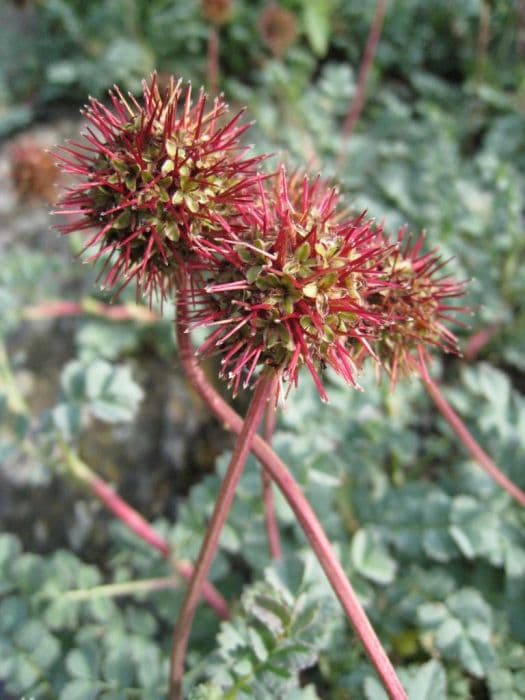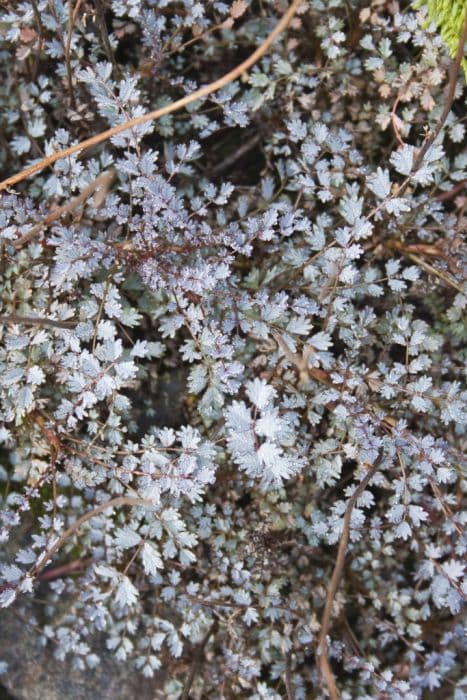Laxton's Fortune Apple Malus domestica 'Laxton's Fortune' (D)

ABOUT
Malus domestica 'Laxton's Fortune', commonly known as apple tree 'Laxton's Fortune', is a variety of apple tree known for producing attractive fruit. This tree is deciduous, meaning it sheds its leaves annually. It showcases a spreading canopy with branches that extend outward, often laden with clusters of blossoms in the spring. The flowers are typically white with a touch of pink, exuding a fragrant scent that attracts pollinators such as bees. As the season progresses, the flowers give way to the fruit for which the tree is named: apples. The 'Laxton's Fortune' apple is recognized by its greenish-yellow skin that often has a reddish-orange flush or stripes when ripe. The skin may also exhibit russet dots that add to its character. The apples are of medium size, with a round to slightly conical shape. The flesh is white to cream in color, known for being juicy and firm with a fine texture. The leaves of the apple tree 'Laxton's Fortune' are simple and alternate, with an oval shape and a finely toothed margin. They are typically a vibrant green, adding a lush look to the tree through the growing season. In autumn, the foliage may turn to shades of yellow or gold before falling to the ground. Overall, apple tree 'Laxton's Fortune' is valued both for its aesthetic appeal as an ornamental tree and for its delicious fruit, which is often used for eating fresh, cooking, or making cider.
About this plant
 Names
NamesFamily
Rosaceae.
Synonyms
Laxton's Fortune Apple, Fortune Apple.
Common names
Malus domestica 'Laxton's Fortune'.
 Toxicity
ToxicityTo humans
The plant in question is commonly known as apple. Apples are not toxic to humans and are widely consumed as a healthy fruit. However, the seeds within the apple core contain a compound called amygdalin, which can release cyanide when digested. Cyanide is a potent chemical, which can be poisonous in large doses. Small quantities of apple seeds are generally not harmful to humans as the body can detoxify cyanide in small doses and the hard seed coating may prevent release of the toxin. Consuming large amounts of apple seeds could potentially lead to symptoms of cyanide poisoning, which include headache, dizziness, confusion, anxiety, vomiting, and in extreme cases, respiratory failure and death. Nevertheless, it is very rare for someone to accidentally ingest enough apple seeds to cause harm.
To pets
The apple is the common name for the plant Malus domestica 'Laxton's Fortune'. Apples, in general, are considered to be safe for many pets to eat in moderate amounts. However, as with humans, the seeds contain amygdalin, which can cause cyanide poisoning if ingested in large quantities. Signs of cyanide poisoning in pets can include difficulty breathing, panting, shock, dilated pupils, and in severe cases, collapse and death. It is important to keep in mind that the core and seeds of apples should not be fed to pets to avoid any risk. Additionally, some pets might have sensitivities or allergies to apples, so it's best to introduce the fruit slowly into their diet and in small quantities.
 Characteristics
CharacteristicsLife cycle
Perennials
Foliage type
Deciduous
Color of leaves
Green
Flower color
White
Height
12-15 feet (3.7-4.6 meters)
Spread
12-15 feet (3.7-4.6 meters)
Plant type
Tree
Hardiness zones
5-8
Native area
Asia
Benefits
 General Benefits
General Benefits- Provides fresh fruit: The 'Laxton's Fortune' apple tree produces edible apples that can be consumed fresh off the tree.
- Enhances garden aesthetics: This variety has decorative value with its attractive blossoms in spring and fruits in late summer or fall.
- Supports wildlife: Offers food and habitat for various birds and insects, especially when the apples are left on the tree.
- Pollination partner: Can serve as a pollinator for other apple varieties that require cross-pollination to bear fruit.
- Homemade products: Apples can be used to create homemade goods such as pies, sauces, and cider.
- Educational tool: Can be used for educational purposes, such as teaching about plant growth, pollination, and fruit development.
- Shade provision: A mature 'Laxton's Fortune' apple tree provides shade in the landscape during the warmer months.
 Medical Properties
Medical PropertiesThis plant is not used for medical purposes.
 Air-purifying Qualities
Air-purifying QualitiesThis plant is not specifically known for air purifying qualities.
 Other Uses
Other Uses- Natural Dye: The skins and cores of apples, including the variety 'Laxton's Fortune', can be used to create natural dyes for fabric, yielding a range of earthy tones.
- Photography: Apple juice can be used as a component in the development of photographic film, where its acidity helps to regulate the pH of the developing solution.
- Educational Tool: The growth and anatomy of the apple tree can serve as an excellent tool for educational purposes, teaching topics of botany and plant life cycles.
- Woodworking: The wood from apple trees is valued for its density and fine grain, making it suitable for crafting small wooden objects like handles and artisanal crafts.
- Insect Trap: Chopped apple can act as bait in homemade insect traps due to its sweet smell that attracts fruit flies and other insects.
- Play Dough: Apple peels and cores can be boiled down with flour and salt to create a natural and safe play dough for children.
- Animal Feed: The flesh of apples can be used as supplemental feed for livestock, particularly pigs, offering a source of natural sugars and fiber.
- Potpourri: Dried apple slices and peels can be included in potpourri mixes for a sweet-scented and natural air freshener.
- Fermentation Projects: Apple scraps can be used in home fermentation projects to create homemade vinegars or to kickstart the fermentation process in other foods.
- Wood Smoking: Small branches or chips from the apple tree can be used for smoking meats, imparting a mild, fruity flavor to the smoked products.
Interesting Facts
 Feng Shui
Feng ShuiThe apple tree is not used in Feng Shui practice.
 Zodiac Sign Compitability
Zodiac Sign CompitabilityThe apple tree is not used in astrology practice.
 Plant Symbolism
Plant Symbolism- Beauty: The Malus domestica, commonly known as the apple tree, is often associated with beauty due to its delicate blossoms and attractive fruit.
- Knowledge: Apples have been symbolic of knowledge, inspired by the fruit from the Tree of Knowledge in biblical tradition.
- Abundance: With its prolific fruit, the apple tree represents abundance and generosity.
- Eternal life: In Greek mythology, apples are associated with eternal life, as seen in the story of the golden apples in the Garden of the Hesperides.
- Love: The apple tree can also symbolize love and romance, owing to various mythologies and folktales where apples are featured as tokens of affection.
 Water
WaterThe apple tree variety known as 'Laxton's Fortune' requires regular watering, especially during the growing season. It is best to water this tree deeply once a week, providing about 1 to 2 gallons of water for each year of the tree's age, not exceeding 10 gallons for mature trees. During hot and dry periods, you may need to water twice weekly to maintain moisture around the roots. It's important to avoid waterlogged soil; hence, proper drainage should be ensured. In the dormant season, reduce watering frequency as the tree requires less water.
 Light
Light'Laxton's Fortune' apple trees thrive best in full sun, where they can receive at least six hours of direct sunlight daily. The ideal spot for these trees is in an open area away from taller structures or trees that could shade them. Ensure they are planted where they can get unfiltered sunlight for the better part of the day to promote healthy growth and fruit production.
 Temperature
Temperature'Laxton's Fortune' apple trees can tolerate a broad range of temperatures but grow best when daytime temperatures are between 60°F and 75°F. The minimum temperature they can survive is around -30°F, while they can also withstand temperatures up to 90°F for short periods. However, extended exposure to temperatures outside of the ideal range may stress the plant and affect fruiting.
 Pruning
PruningPruning 'Laxton's Fortune' apple trees is important for several reasons: to maintain a strong structure, remove damaged or diseased limbs, and encourage better fruit production. Prune in late winter when the tree is dormant, before new growth begins. Thin out crowded branches and remove any that cross or rub against each other. Aim to prune annually to keep the tree's size manageable and to refresh productive wood.
 Cleaning
CleaningAs needed
 Soil
SoilApple trees, such as 'Laxton's Fortune', prefer well-draining loamy soil with a pH between 6.0 and 7.0. A mix of one-third topsoil, one-third peat moss, and one-third aged compost or well-rotted manure works best to provide the nutrients and drainage needed. Amending the soil with organic matter and ensuring adequate calcium availability will support healthy growth and fruit production.
 Repotting
RepottingApple trees like 'Laxton's Fortune' are typically not repotted as they are grown outdoors. However, if grown in containers, young trees may need repotting every 2 to 3 years during their early growth stages to accommodate root development. Mature apple trees can be top-dressed with fresh soil instead of repotting.
 Humidity & Misting
Humidity & Misting'Laxton's Fortune' apple trees are adaptable to a wide range of humidity levels but perform best with moderate atmospheric moisture. They do not require any special humidity adjustments when grown outdoors; natural precipitation and dew are usually sufficient to meet their humidity needs.
 Suitable locations
Suitable locationsIndoor
Not ideal for indoors; requires full sun, space, and pruning.
Outdoor
Plant in full sun, provide regular water and yearly pruning.
Hardiness zone
4-8 USDA
 Life cycle
Life cycleMalus domestica 'Laxton's Fortune', commonly known as the 'Laxton's Fortune' apple, begins its life as a seed, which, when planted and provided with the right conditions, germinates and sprouts into a seedling. With adequate sunlight, water, and soil nutrients, the seedling grows into a young apple tree over several years. During this juvenile phase, the tree develops its root system, branches, and leaves but does not yet produce fruit. Upon reaching maturity, which typically occurs after a few years, the tree starts to blossom in the spring; these flowers are then pollinated, usually by bees, leading to the development of apples. Over the summer, the apples grow and ripen, ready to be harvested in late summer or autumn. After harvest, the tree enters a period of dormancy in winter, only to begin the cycle again with new blossoms in the following spring.
 Propogation
PropogationPropogation time
Late winter-early spring
Malus domestica 'Laxton's Fortune', commonly known as the Laxton's Fortune apple, is a variety that is often propagated by grafting. This method is particularly popular as it ensures that the new trees will bear fruit that is true to the variety's characteristics. Grafting is typically performed in late winter to early spring before the sap starts to flow and the trees come out of dormancy. During this process, a scion, which is a young shoot or twig from the Laxton's Fortune apple tree, is inserted into a cut made on the rootstock, which is another apple tree that has been chosen for its hardy root system. The two parts are then securely fastened together using grafting tape or a similar material until they grow together and form a strong union, creating a new Laxton's Fortune apple tree that combines the desirable fruit qualities of the scion with the robustness of the rootstock.









